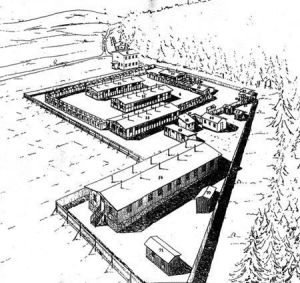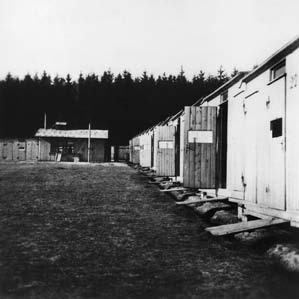 The camp in Lety used to stand two kilometres east of the village. Since August 8, 1940 it served as a labour camp, then since January 1, 1942 it was an assembly camp and since August 2, 1942 it became a Gipsy camp. Its fenced part covered an area of 66 are, to which belonged another 11.2 are of unfenced farmland. There was a wooden house which belonged to the camp as well and should have been used as a classroom or in the event of an emergency as a first-aid station. In front of the entrance to the camp there was a two-storey house, which belonged to the headquarters and next to the road that led to the village Lety, there were four smaller residential houses for supervisors and administrative authorities. On June 12, 1942 after all of the construction adjustments had been made, the central Criminal office in Prague received a report that the capacity of the camp was increased to 300 adults. Right at the beginning a heartless fifty-two year captain of gendarmerie Josef Janovský was appointed the director of the camp.
The camp in Lety used to stand two kilometres east of the village. Since August 8, 1940 it served as a labour camp, then since January 1, 1942 it was an assembly camp and since August 2, 1942 it became a Gipsy camp. Its fenced part covered an area of 66 are, to which belonged another 11.2 are of unfenced farmland. There was a wooden house which belonged to the camp as well and should have been used as a classroom or in the event of an emergency as a first-aid station. In front of the entrance to the camp there was a two-storey house, which belonged to the headquarters and next to the road that led to the village Lety, there were four smaller residential houses for supervisors and administrative authorities. On June 12, 1942 after all of the construction adjustments had been made, the central Criminal office in Prague received a report that the capacity of the camp was increased to 300 adults. Right at the beginning a heartless fifty-two year captain of gendarmerie Josef Janovský was appointed the director of the camp.
1940
The first guards, members of the gendarmerie, came to the camp on June 6, 1940 as they received a command to work in the. Afterwards the first 12 prisoners were brought there who had to prepare accommodation for the newcomers.
The prisoners used to arrive to the camp after they had completed they execution of a punishment and they were supposed to stay in the labour camp to learn to work before they were released. Upon arrival at the camp they were placed into classes. Each new comer was placed to the third class. The prisoners worked on the road construction, in fields and woods in the camp neighbourhood. There was a contractual doctor from the neighbourhood who used to come to the camp, and serious cases of illness were transported to the hospital in Písek. If behaving well, the prisoner was transferred to another class and then into the first class. This was one of the ways that led to the release of prisoners. By the end of 1940, 233 people went through the camp.
1941
Throughout the whole year the camp served in accordance with the original intention of the project and without major changes. There were 537 people brought to the camp, 45 of whom were of Roman origin. During that year three deaths of prisoners were reported. Two died in the hospital in Písek and one after he had been released from the camp. Cause of death was hard work and the health status of persons.
1942
On July 10, 1942 following the template of the SS Reich commander, there was a decree issued by the leader of the protectorate police ordering to combat so-called Gypsy plague. Afterwards, based on the decree, the police authorities and the gendarmerie stations registered all "Gipsies, Gipsy and half-breeds living in Gipsy style" (Note the striking similarity with the date of the Lidice tragedy).
 By this decision life of the disciplinary camp begins to change and a period of so-called Gipsy camp begins. On July 31, 1942 60 from 113 recorded prisoners were moved to the enforcement office in Prague-Ruzyně. 33 were at that time in custody or detached working place. There were 20 prisoners left in the camp, mainly Romany men who thus immediately became prisoners of Gipsy camp, and were there to assist the reconstruction of the camp for newly arrived.
By this decision life of the disciplinary camp begins to change and a period of so-called Gipsy camp begins. On July 31, 1942 60 from 113 recorded prisoners were moved to the enforcement office in Prague-Ruzyně. 33 were at that time in custody or detached working place. There were 20 prisoners left in the camp, mainly Romany men who thus immediately became prisoners of Gipsy camp, and were there to assist the reconstruction of the camp for newly arrived.
On August 2, 1942 The first group of 66 Romany men was registered in the camp. The intervened arrived by train to the train station in Mirovice from where they were escorted accompanied by gendarmerie to the camp which was approximately 6 kilometres away. Others come into the camp on wagons pulled by horses with whole families under the supervision of gendarmes. Horses, wagons, tents, valuables, musical instruments, books and bankbooks were taken away from them upon arrival and taken into custody, which was not too careful.
In the camp the men were accommodated separately, women were together with small children and older children together. The influx of new prisoners was so big that On August 15, 1942 there was already 1145 people registered in the camp. In addition to "Gipsies and Gipsy half-breeds" there were also "people living in a Gipsy way" recorded in the camp. The first new born child was also registered after a short while, totally there were13 boys and 23 girls born in the camp, the last registration number belonged to the Jewish doctor who was assigned here in January 1943.
Most of the prisoners, who came into the camp, were not in good health condition. The youngest suffered from malnutrition, elderly from physical weakness and old men, even though there was not too many of them, were shabby, had skin and genital diseases and tuberculosis. Patients would receive individual dining and children were provided morning and afternoon snacks since December 1942. The health status of prisoners was still deteriorating due to the state of the buildings, which were damp and mould, but also because of the scarcity of water, which had to be partly imported. Already on August 3, 1942 there were already first ill reported at the infirmary, and within three weeks there were about fifty. On October 15, 1942 the first three patients had to undergo epidemiological examination with suspected typhoid. Deteriorating and dangerous situation was totally underestimated by the camp commander, who in his report stated that the health status of prisoners is normal and there is no risk of epidemic in the camp. On December 13, 1942 first 5 patients with found typhoid were reported. Disease spread rapidly and at the end of December it grew to epidemic. 22 people (20 prisoners and 2 gendarmes) were hospitalized in hospitals. Only now the commander of the camp reported the whole situation to his management, who commented upon his errors as he failed his duties and was dismissed. The commander of Gipsy camp in Hodonín became a new commander then.
Even before the arrival of the new camp commander the first 93 prisoners were sent to Prague's enforcement office marked as ASO (asocial). According to the announcement from there they should have all gone to the work camp in Auschwitz. The fact was somewhat different; on December 2, 1942 they all went by train from Prague's main railway station to Oswiecim, where death was waiting for them instead of work.
1943
 Morbidity and mortality of prisoners has grown to catastrophic proportions. On January 12, 1943 the daily report stated that "the physical condition of Gipsy women is so bad that there are no women capable of washing and cleaning" and fourteen days later, the report notes that "many prisoners are in such pitiful condition that they must be considered as hopeless. Their death is no longer possible to avoid ". On January 23, 1943 dissection of one of the dead prisoners was ordered, which confirmed that the cause of death is typhus. Infection began to spread very quickly and attacked in particular those prisoners who had been a weakened by the typhoid. New epidemic was soon to come, and so in mid-February 1943 there were 15 people registered as infected with enteric fever and 34 with typhoid fever. On February 17, 1943 an order was issued that the camp should be closed hermetically, the fence repaired, to avoid any escape that would be punished by death and no one shall leave the camp, including staff. This order (quarantine) was valid until the complete liquidation of the camp. Totally 30 men, 48 women, 3 boys, 4 girls and 241 children younger than 14 years died in the camp. Before then the cemetery in Mirovice was being used for burying prisoners. There were 174 people buried altogether. At that time the cemetery was running out of capacity and also there was a fear of spread of the epidemic, therefore provisional burying-place was ordered to be established. On January 18, 1943 the camp commander reported that in the neighbourhood of the camp there was a provisional fenced burying-place established where the bodies of dead prisoners were to be buried.
Morbidity and mortality of prisoners has grown to catastrophic proportions. On January 12, 1943 the daily report stated that "the physical condition of Gipsy women is so bad that there are no women capable of washing and cleaning" and fourteen days later, the report notes that "many prisoners are in such pitiful condition that they must be considered as hopeless. Their death is no longer possible to avoid ". On January 23, 1943 dissection of one of the dead prisoners was ordered, which confirmed that the cause of death is typhus. Infection began to spread very quickly and attacked in particular those prisoners who had been a weakened by the typhoid. New epidemic was soon to come, and so in mid-February 1943 there were 15 people registered as infected with enteric fever and 34 with typhoid fever. On February 17, 1943 an order was issued that the camp should be closed hermetically, the fence repaired, to avoid any escape that would be punished by death and no one shall leave the camp, including staff. This order (quarantine) was valid until the complete liquidation of the camp. Totally 30 men, 48 women, 3 boys, 4 girls and 241 children younger than 14 years died in the camp. Before then the cemetery in Mirovice was being used for burying prisoners. There were 174 people buried altogether. At that time the cemetery was running out of capacity and also there was a fear of spread of the epidemic, therefore provisional burying-place was ordered to be established. On January 18, 1943 the camp commander reported that in the neighbourhood of the camp there was a provisional fenced burying-place established where the bodies of dead prisoners were to be buried.
Not even the disease, which spread very quickly, could stand in a way to inclusion in transport to Oswiecim. In March the first 7 patients were transported to whom another 13 prisoners from Lety were added and with the largest transport which took place on May 4, 1943 another 307 people were moved. Totally there were 420 prisoners from Lety that went through the gate of Oswiecim. 215 from them were men and boys and 205 of women and girls.
Attachments: